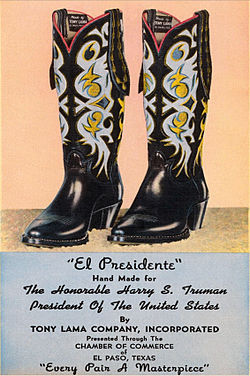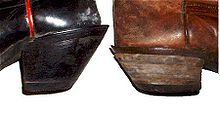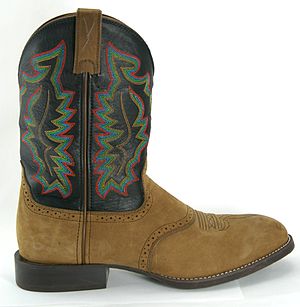- Cowboy boot
-
Cowboy boots refer to a specific style of riding boot, historically worn by cowboys. They have a high heel, rounded to pointed toe, high shaft, and, traditionally, no lacing. Cowboy boots are normally made from cowhide leather but are also sometimes made from "exotic" skins such as alligator, snake, ostrich, lizard, eel, elephant, sting ray, elk, buffalo, and the like.
There are two basic styles of cowboy boots, western (or classic), and roper. The classic style is distinguished by a tall boot shaft, going to at least mid-calf, with an angled "cowboy" heel, usually over one inch high. A slightly lower, still angled, "walking" heel is also common. Although western boots can be customized with a wide variety of toe shapes, the classic design is a narrowed, usually pointed, toe.
A newer design, the "roper" style, has a short boot shaft that stops above the ankle but before the middle of the calf, with a very low and squared-off "roper" heel, shaped to the sole of the boot, usually less than one inch high. Roper boots are usually made with rounded toes, but, correlating with style changes in streetwear, styles with a squared toe are seen. The roper style is also manufactured in a lace-up design which often fits better around the ankle and is less likely to slip off, but these two features also create safety issues for riding.
Contents
History
Riding boots had been a part of equestrian life for centuries. Until the industrial age, boots were individually handmade in many different styles, depending on culture. Early cowboy boot designs, along with other cowboy accoutrements, were also heavily influenced by the vaquero tradition imported from Spain to the Americas, dating back to the early 16th century. Military boots designed for cavalry riders also had an influence.
Later, the industrial revolution allowed some styles of boots to be mass-produced. One mass-produced boot style, the Wellington boot, (a shorter but cavalry-oriented boot) was popular with cowboys in the USA until the 1860s.
During the cattle drive era of 1866–1884, the cowboy was not apt to ruin a good pair of dress boots while working, but some owned more decorative dress boots to wear in town. The basic style elements permeated even working boots, and made the Wellington obsolete. Fashion magazines from 1850 and 1860 show the cowboy boot with topstitching, cutouts of geometric or other natural elements and underslung heel.
The American-style boot was taken up by bootmakers in the cattle ranching areas of Texas, Oklahoma, and Kansas.[1] Two of the best known early bootmakers of the era were Charles Hyer of Hyer Brothers Boots in Olathe, Kansas, and H. J. "Big Daddy Joe" Justin of Justin Boots in Spanish Fort, Texas and later Nocona, Texas. After Justin moved closer to Dallas where shipping was easier, the Nocona brand of cowboy boots was made by Enid Justin Stelzer, eldest daughter of Joe Justin, who stayed in Nocona with her husband, and the couple continued the family business.[2] After the couple divorced, the Olsen-Stelzer brand was started by Stelzer.
Design
When mounting and, especially, dismounting, the slick, treadless leather sole of the boot allowed easy insertion and removal of the foot into the stirrup of the Western saddle. The original toe was rounded and a bit narrowed at the toe to make it easier to insert. While an extremely pointed toe is a modern stylization appearing in the 1940s, it adds no practical benefit, and can be uncomfortable in a working boot.
While in the saddle, the tall heel minimized the risk of the foot sliding forward through the stirrup, which could be life-threatening if it happened and the rider were to be unseated. There was often considerable risk that a cowboy would fall from a horse, both because he often had to ride young, unpredictable horses, but also because he had to do challenging ranch work in difficult terrain, that often meant that he could accidentally become unseated by a quick-moving horse. If a rider fell from a horse but had a boot get caught in the stirrup, there arose a very great risk that the horse could panic and run off, dragging the cowboy, causing severe injury and possible death.
The tall leather shaft of the boot helped to hold the boot in place in the absence of lacing. The tall shaft, comfortably loose fit, and lack of lacing all were additional features that helped prevent a cowboy from being dragged since his body weight could pull his foot out of the boot if he fell off while the boot remained stuck in the stirrup. While mounted, the shaft also protected the lower leg and ankle from rubbing on the stirrup leathers, as well as fending off brush and thorns, particularly if also worn with chaps or chinks. While dismounted, the shaft helped protect the leg and foot from rocks, brush, thorns, and rattlesnakes. In wet weather or creek crossings, the high tops helped prevent the boot from filling with mud and water.
The modern roper style boot with a low heel and shorter shaft emerged from the traditional design in response to the needs of modern rodeo, particularly calf roping, where the cowboy had to run to tie the calf as well as to ride. The lower shaft resulted in a less expensive boot, but also allowed the boot to be more easily removed. A laceup design for roper boots became popular as it prevented the boot from falling off too easily and provided more ankle support when on foot, though the lacer also has safety issues because it will not fall off if a rider is hung up in a stirrup, and, lacking a smooth upper, the lacings themselves may make it easier for the boot to become caught in the stirrup in the first place.
Decoration varied widely. Early boots were cowhide leather pieced together with single rows of top stitching, but as custom boots were made, cowboys asked for decorative stitching, cutouts in the high tops (early on, often Texas stars), and different materials. The interaction of wild west shows and later, western movies, influenced styles that working cowboys at times adopted. Modern cowboy boots are available in all colors and can be made from just about every animal whose skin can be made into leather, including exotic materials such as alligator and ostrich.
One accessory used with cowboy boots are spurs, which are sometimes attached to the heel of each boot for the purpose of cueing a horse while riding.
Fitting
Many cowboy boot companies have been in operation since the 19th century. Each manufacturer has developed its own proprietary lasts for producing boots, which are considered trade secrets and are highly guarded. Because of this, standardization has been slow, and fitting between companies is not always consistent. When considering wearing a cowboy boot from a different manufacturer, it is recommended to seek assistance from a knowledgeable merchant who specializes in cowboy boots if a person cannot try them on in person. Some wearers will swear by one manufacturer's fit, while others will not perceive any difference between brands.
The fit will vary depending on the type of toe that is sought. Pointed toes leave a narrower space between the toes and the tip of the boot which may cause discomfort, though can be minimized by selecting a half size larger than the wearer's normal size. A rounder toe (like a roper or a Wellington) will fit more like a regular shoe. Another factor is leather. A cowhide or kidskin boot will become softer with wear, molding to the wearer's foot. That is why it is recommended to select a snug size because the boot will eventually "break in" and a loose fitting boot at the time of purchase will become sloppy.
However, some individuals also are unaccustomed to the slight slippage of the heel in a new, non-laced cowboy boot, particularly with a cowboy heel, and buy a too-small boot in an attempt to stop this slippage. But a small amount of slippage is also normal at first. As the boot breaks in, the slippage will stop.
Boot hooks are often required to put on a new pair of boots until they soften in the arch and break in. A boot jack is recommended for removal, though care must be taken not to damage the heel of the boot when using a jack.
See also
- Cowboy
- Riding boot
- Cowboy hat
- Western wear
- Boot
- Justin Boots
- Acme Boots
- Tony Lama
- The Frye Company
- Double-H Boots
- Lucchese Boot Company
References
- ^ Barbara Brackmann, Kansas Historical Society, "How Kansas gave Texas the Boot"
- ^ Enid Justin: Lady Bootmaker
- Texas Monthly, January 1999: Art of the Boot
- Howard Zinn, A People's History of the United States, New York: Harper Collins, 2003.
High-heeled footwear Shoes 
Boots Ballet boot · Beatle boots · Cowboy boot · Fashion Boot · Kinky boots · Knee-high boots · Thigh-length boots · WinklepickersTypes of heel People and brands ALDO · Manolo Blahnik · Jimmy Choo · Kenneth Cole · Patrick Cox · Cole Haan · Salvatore Ferragamo · Maud Frizon · Hush Puppies · Charles Jourdan · Beth Levine · Christian Louboutin · Steve Madden · Bruno Magli · Nine West · Beatrix Ong · Pleaser · Prada · Sergio Rossi · Roger Vivier · Stuart Weitzman · United Nude · Yotam SolomonFootwear Men's dress shoes Brogues · Derbies · Loafers · Court shoes · Monks · Oxfords · Spectator shoes (Co-respondent shoes) · Venetian style shoes · Winklepickers · Brothel creepersWomen's dress shoes Ballet flats · Court shoes (Pumps) · Loafers · Slingbacks · Mules · Mary Janes · Mojari · Saddle shoes · Venetian style shoes · WinklepickersOther shoes Clog · Espadrilles · Flip-flops · Galoshes · Geta · Giveh · Moccasins · Platform shoes · Sandals · Slides · Slippers · VeldskoensMilitary footwear Ammunition boots · Cold weather boots · Combat boots · Jackboots · Jump boots · Jungle boots · Tactical boots · Tanker boots · Trench bootsSport-related footwear Fashion boots Work boots/shoes Australian work boots · Chukka boot · Cowboy boot · Hip boot · Rigger boot · Steel toe boots · Waders · Engineer bootsOther boots Historical Categories:- Boots
- High-heeled footwear
- Western wear
- Rider apparel
- History of clothing (Western fashion)
- History of fashion
Wikimedia Foundation. 2010.




